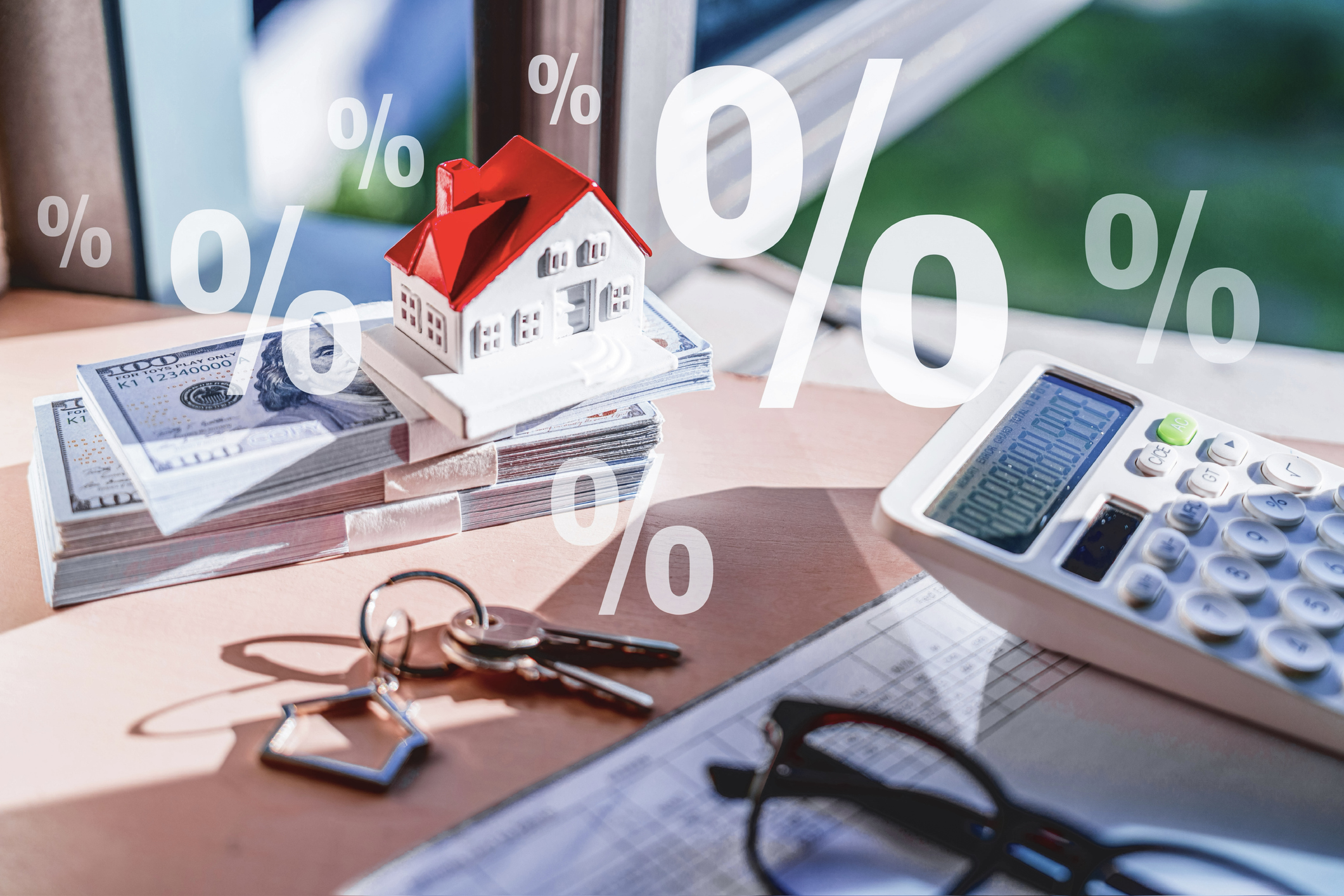Get Cash From Your Home
It’s easier now to tap the equity in your house, and rates are still attractive. But you’ll need a top credit score.

With home prices rising steadily over the past several years, home-equity borrowing is making a comeback. Loans and lines of credit secured by home equity are more attractive than credit cards and unsecured personal loans because you get a more generous credit limit at a lower cost. The interest you pay is usually tax-deductible, which also trims your cost. The downside: The loan is secured by your home.
The average fixed rate nationally for a home-equity loan was 6.2% as of late April, and the average variable rate for a line of credit was 5.2%, according to HSH.com, which regularly surveys home-equity lenders. But the better your credit score and the more equity you have, the lower the rate you can get. Wells Fargo recently offered a line of credit with a 2.615% fixed rate for the first year and a variable rate as low as prime plus 0% after that. (The prime rate was recently 3.25%.) On the East Coast, TD Bank offered a line of credit at 2.75% (prime minus 0.5 percentage point), with a minimum credit line of $200,000, or a five-year fixed-rate loan at 4.39% for a balance of $50,000 to $99,999.
Most lenders require a minimum FICO credit score of 720 (out of 850) to get the best rates, and impose a maximum combined loan-to-value ratio (LTV) of 80%. That means the balance of your first mortgage plus home-equity debt divided by the current market value of your home can’t exceed 0.8, or 80%. (The limit may be lower—70%—for condos and investment properties.) Before the housing bust, many home-equity lenders went as high as a 100% LTV, and a few lenders still offer generous terms. Many homeowners still can’t jump the equity hurdle, especially those who bought at the top of the market with little or no money down, then saw the value of their home fall dramatically.
From just $107.88 $24.99 for Kiplinger Personal Finance
Become a smarter, better informed investor. Subscribe from just $107.88 $24.99, plus get up to 4 Special Issues

Sign up for Kiplinger’s Free Newsletters
Profit and prosper with the best of expert advice on investing, taxes, retirement, personal finance and more - straight to your e-mail.
Profit and prosper with the best of expert advice - straight to your e-mail.
How they work
There are two varieties of home-equity lending. A home-equity loan provides a lump-sum payout that may work well for a one-time expense, such as a car purchase or a specific home project. It offers the predictability of a fixed rate of interest and repayment in equal monthly payments over a term of five to 20 years.
A home-equity line of credit (HELOC) is a revolving line of credit that you can tap whenever you like by using a check, a credit or debit card connected to the account, or an electronic transfer. You could use it to pay for ongoing or variable expenses, such as college, medical bills or completed phases of a home-renovation project. You’ll pay a variable rate of interest on any outstanding balance.
HELOCs provide an initial withdrawal period, usually 10 years, during which you can borrow up to your limit. During the draw period, you may choose whether to repay principal and interest or interest only. You could get hit with a substantially larger payment when the repayment period begins. Because your home secures the debt, the lender could initiate foreclosure if you fail to repay it. However, the holder of your first mortgage must agree, and that’s unlikely as long as you continue to make your first-mortgage payments.
Shopping smart
“You’re borrowing your own money—your own equity—so you want to shop around for the best terms available,” says Keith Gumbinger, vice president of HSH.com. Start with the holder of your first mortgage and the bank where you have your savings and checking accounts. Gumbinger says that smaller lenders, such as savings and loan associations, savings banks, and credit unions, may offer slightly lower rates. Rates from credit unions for loans and lines of credit recently averaged about 0.25 percentage point less than those offered by banks, according to Informa Research Services, which tracks consumer lending. Wherever you go, you may qualify for a discount of 0.25 or 0.5 percentage point if you open a checking or savings account or arrange for automatic payments. You can check rates online at www.bankrate.com, www.lendingtree.com or www.mybanktracker.com.
Whether you’re seeking a loan or a line of credit, a high credit score will help you snag a lower rate (your rate will also depend on the LTV, the term of repayment and the size of the loan or line of credit). Review your credit reports several months before you shop (you can get a free copy of your credit report from each of the three major bureaus once a year from www.annualcreditreport.com) and correct any errors (see Take Charge of Your Credit). Check your credit score, too; you can get a free score from CreditKarma.com.
The interest rate on home-equity loans recently ranged from 3.89% to 9.84%, according to a survey from HSH. Rates on HELOCs ranged from 3.24% to 7.5%. Michele Livingston, director of lending at Umpqua Bank, based in Portland, Ore., cautions that an advertised rate that’s unusually low may be available only to borrowers who have the best credit scores and qualify to borrow larger amounts. Rates are so low now that most lenders don’t need to offer an introductory, “teaser” rate. But if you are offered one, Livingston recommends that you find out how long it lasts and what the rate will be after it expires.
Closing costs for a home-equity loan can run about 2% of the payout ($600 on a $30,000 loan, for example), which includes transfer taxes, fees for origination, appraisal, recording the loan documents, and a title search, and insurance to protect the lender. Lenders generally charge a flat fee for a HELOC, which can range from a few hundred dollars to $1,000, including the cost of an appraisal. Lenders commonly eat all of the costs except for the appraisal, but they’ll impose an early-termination fee equal to the lender’s actual closing costs or up to 2% of the outstanding balance if you close the line within two to three years.
Some lenders offer a “loan within a line” type of HELOC. You can convert all or part of your outstanding balance from a variable to a fixed rate and repay that portion over, say, up to 20 years. This option could prove valuable if rates begin to rise.
Crossing the finish line
Taking out a home-equity loan or line of credit is less of a hassle than closing a first mortgage, and you can generally close on the loan within four to six weeks. After you submit an application, the lender will pull your credit report and ask you to document your income with your most recent pay stub and W-2 forms from the past two years. If you’re self-employed or want to use interest, dividend or bonus income to qualify, you can expect to turn over tax returns from the past two or three years. The lender may also ask you for proof of hazard and flood insurance for your home.
The lender will also verify the market value of your home. For example, Pentagon Federal will review your property-tax assessment and make an automated valuation based on recent comparable sales or conduct an appraisal. If the no-cost tax assessment supports the amount you want to borrow, PenFed will use it. However, an appraisal (at a cost of $350 to $525) usually produces the highest valuation, and PenFed often requires it when the total amount of the first and second loans exceeds $250,000.
The lender will also conduct a title search to ensure that if you default, it gets reimbursed second, after your first-mortgage lender. Because the title work is more limited than for first mortgages and the loan amount is smaller, the costs of the title work and lender’s policy are lower.
As part of the qualification process, lenders calculate your monthly debt-to-income ratio (total monthly debt repayment divided by gross monthly income) to ensure that you can handle the payment. They may set the upper limit at 43%, and if you can’t afford the payment based on that limit, they may just reduce the loan amount, says Livingston. Under federal law, you have three business days (including Saturday) after you close to cancel a signed credit agreement without penalty. On the fourth day, you’ll receive access to the money.
Managing your loan
You can probably deduct the interest you pay on up to $100,000 of home-equity debt. That’s what the law calls debt secured by your principal residence or a second home that is not used to buy or improve the property. Keep track of how you spend the money you get by tapping your equity because you might qualify to deduct interest on more than $100,000. If you use a HELOC to pay for renovations on your home, for example, that doesn’t count against your $100,000 limit. (Instead, it counts against the separate $1 million limit for funds borrowed to buy or improve your home.)
The $100,000 cap applies to borrowing for things such as buying a car, covering the cost of a vacation or paying off credit cards. Trading $10,000 of nondeductible credit card debt at 18% for $10,000 of deductible debt at 4.5% would slice the after-tax carrying costs from $1,800 to $338 a year for a taxpayer in the 25% bracket. (Caveat: Interest on home-equity debt not used for improvements is not deductible if you’re subject to the alternative minimum tax.) Be sure to document how you spend the money on home improvements so that you avoid eating away at the home-equity allowance.
If you must sell your home or close a line of credit and incur your lender’s prepayment penalty, that amount is deductible as mortgage interest, too. For more information, see IRS Publication 936, Home Mortgage Interest Deduction, at www.irs.gov.
Many lenders routinely charge HELOC borrowers an annual fee (typically $50, but as much as $100) after the first year, or they may charge it if you don’t meet certain minimums for use (a percentage of the line, average daily balance or number of transactions). They may also charge a transaction fee each time you borrow.
Profit and prosper with the best of Kiplinger's advice on investing, taxes, retirement, personal finance and much more. Delivered daily. Enter your email in the box and click Sign Me Up.

-
 'Boomer Candy' Investments Might Seem Sweet, But Beware
'Boomer Candy' Investments Might Seem Sweet, But BewareProducts such as index annuities, structured notes and buffered ETFs might seem appealing, but sometimes they can rob you of flexibility and trap your capital.
-
 AI Stocks Lead Nasdaq's 398-Point Nosedive: Stock Market Today
AI Stocks Lead Nasdaq's 398-Point Nosedive: Stock Market TodayThe major stock market indexes do not yet reflect the bullish tendencies of sector rotation and broadening participation.
-
 Top Tech Gifts to Grab at Walmart Before Christmas
Top Tech Gifts to Grab at Walmart Before ChristmasBig savings on Apple, Bose, HP, Vizio and more while there's still time to shop.
-
 Amazon Resale: Where Amazon Prime Returns Become Your Online Bargains
Amazon Resale: Where Amazon Prime Returns Become Your Online BargainsFeature Amazon Resale products may have some imperfections, but that often leads to wildly discounted prices.
-
 Roth IRA Contribution Limits for 2026
Roth IRA Contribution Limits for 2026Roth IRAs Roth IRAs allow you to save for retirement with after-tax dollars while you're working, and then withdraw those contributions and earnings tax-free when you retire. Here's a look at 2026 limits and income-based phaseouts.
-
 Four Tips for Renting Out Your Home on Airbnb
Four Tips for Renting Out Your Home on Airbnbreal estate Here's what you should know before listing your home on Airbnb.
-
 Five Ways to a Cheap Last-Minute Vacation
Five Ways to a Cheap Last-Minute VacationTravel It is possible to pull off a cheap last-minute vacation. Here are some tips to make it happen.
-
 How Much Life Insurance Do You Need?
How Much Life Insurance Do You Need?insurance When assessing how much life insurance you need, take a systematic approach instead of relying on rules of thumb.
-
 When Does Amazon Prime Day End in October? Everything We Know, Plus the Best Deals on Samsonite, Samsung and More
When Does Amazon Prime Day End in October? Everything We Know, Plus the Best Deals on Samsonite, Samsung and MoreAmazon Prime The Amazon Prime Big Deal Days sale ends soon. Here are the key details you need to know, plus some of our favorite deals members can shop before it's over.
-
 How to Shop for Life Insurance in 3 Easy Steps
How to Shop for Life Insurance in 3 Easy Stepsinsurance Shopping for life insurance? You may be able to estimate how much you need online, but that's just the start of your search.
-
 Five Ways to Shop for a Low Mortgage Rate
Five Ways to Shop for a Low Mortgage RateBecoming a Homeowner Mortgage rates are high this year, but you can still find an affordable loan with these tips.